
This blog post with the latest statistics about teaching music lessons was compiled by Joanna Shiel. Joanna works as an editorial assistant on the Colourful Keys Blog and as a piano teacher. She’s based in the UK with over 14 years of piano teaching experience and runs her piano studio fully online. She loves hiking, travelling and trying out unique foods. Her dessert of the month is a Mochi doughnut from that new place in town.
The music teaching industry is one of the most under-reported out there. Look up “how much do lawyers make” or “how many hours do most doctors work” and you’ll easily come up with some statistics. If you want to know how much you can make by teaching piano lessons, or any other statistics about teaching music lessons, you won’t have as much luck.
Until we came along, that is. 🙂

Data is important to any industry. It can give us insights into broader trends in the industry and it can let us see how we stack up to the averages.
Proper industry data also legitimises the work we are doing. Music teachers have been learning in recent years to take themselves and their businesses more seriously. Statistics can help the outside world to do the same.
For all these reasons, as well as personal and professional curiosity, we compile this report every year and publish the findings here on the Colourful Keys blog.
This report is based on a survey of 645 teachers from across 14 countries, and was conducted in January and February of 2023. The goal of the survey was to better understand the music teaching industry as a whole, with a specific focus on the income of teachers, the trends in music teaching pedagogy and the working life of teachers around the world.
In this report, you’ll discover music lesson statistics such as:
- The average teaching rates in different locations
- How many hours and weeks most teachers work
- How common recitals and exams are in different countries
- Which areas teachers generally feel most and least confident about teaching
- The overall trends towards teaching creative skills
- How common music teacher association membership is
- The changing role of online lessons in our studios
The more teachers fill in this survey each year, the more valuable the report becomes. Please spread the word about this report and make sure to follow email updates from this blog so you can participate in next year’s survey. It’s really important that this data represent the broad diversity of our industry so it can provide truly meaningful insights.
In this article, I will share some of the key findings from the report and our VMT team’s thoughts about them. If you want to download the complete report, you can do so for free below.
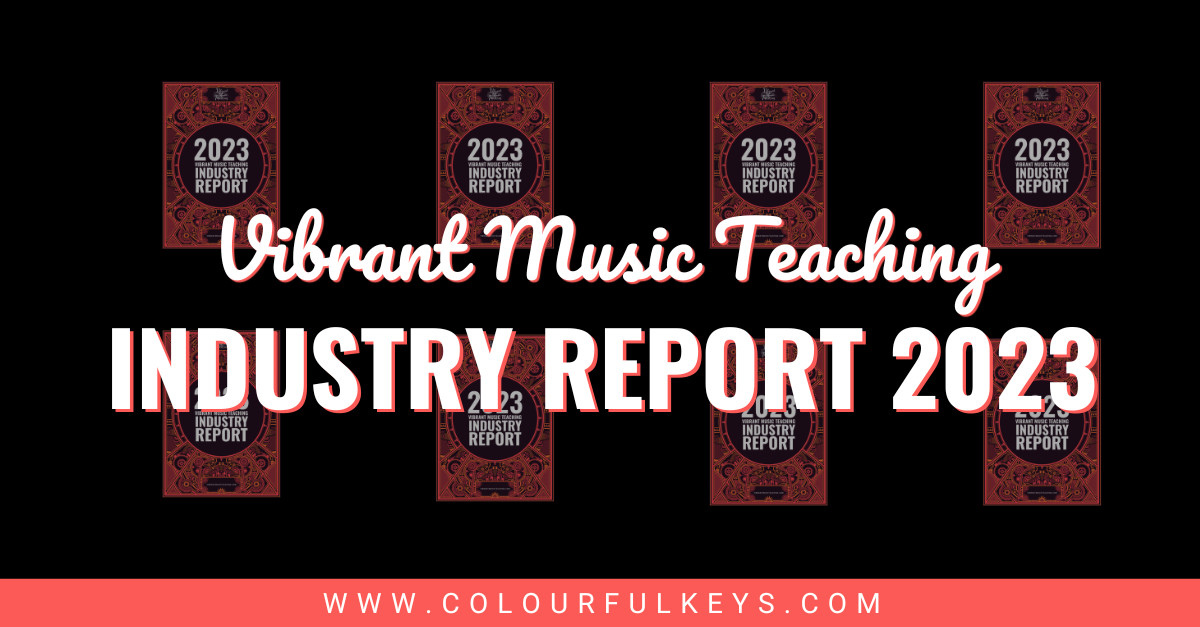
Subscribe to updates and get the 2023 Vibrant Music Teaching Industry Report
Enter your details to subscribe to the newsletter for piano teachers with information, tips and offers.
I hate spam as much as you do! I’ll only send you information that’s directly relevant to music teachers and you can unsubscribe at any time.
If you’re a member of Vibrant Music Teaching you can download the report directly here. No need to wait for an email. 🙂
It’s time to reveal the data in our latest piano teaching industry report 2023! Discover how your studio compares to others globally (and whether you might need to make adjustments to your own).
Average Music Teacher Rates
We asked about rates per teaching hour and converted the currencies to US dollars to provide a direct comparison across the world. Although this is still a broad-brush approach, we hope it gives you some sense of whether your own rates are above or below the norm globally. You still need to factor in the cost of living where you are and how this may be reflected in your rates.
Global Average Music Teacher Rates
The total average is about USD $45 per hour of teaching, with the US being the only country sitting above this average. Europe has the biggest increase, going from $35.38 in late 2021 to $40.75 in early 2023.
Rates have gone down a little from 2021 in Australia & New Zealand, Canada and the UK. This is a worrying trend considering the rise in inflation across the world, but perhaps it’s just an anomaly in our data.
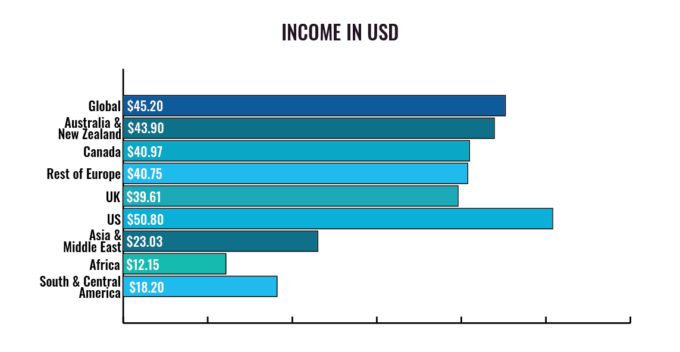
Inflation Impact
Since inflation is so high at the moment, we asked teachers where they are feeling the impact in their businesses. Almost 30% said they haven’t noticed any impact at all, but a significant majority are finding things challenging right now due to inflation.
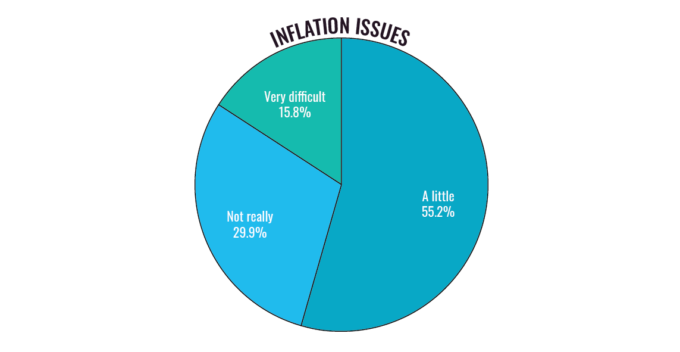
Music Teacher Income Satisfaction
While teachers’ satisfaction with their income went up from 2020 to 2021, it actually declined in 2023. About 5% fewer teachers said they are a 5 on the satisfaction scale with how much they make (out of 5, with 5 being the most satisfied).
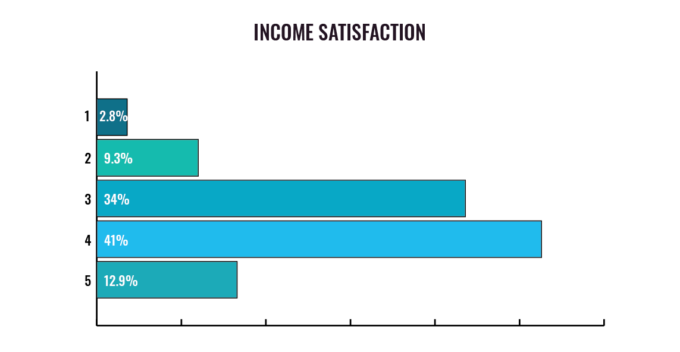
If you’re among those who aren’t satisfied with their income, have a look around to discover what other teachers are charging in your area. You might discover that you can raise your rates without pricing yourself out of the market.
There‘s much more detail about income and rates, along with other statistics about teaching music lessons, in the full report. Get your copy by entering your details below.

Subscribe to the newsletter and get the 2023 Vibrant Music Teaching Industry Report
Enter your details to subscribe to the newsletter for piano teachers with information, tips and offers.
I hate spam as much as you do! I will only send you emails related directly to piano teaching and you can unsubscribe at any time.
If you’re a member of Vibrant Music Teaching you can download the report directly here. No need to wait for an email. 🙂
Lesson Statistics for Music Teaching Studios
The statistics in the 2023 Vibrant Music Teaching Industry Report go far beyond rates – we also asked about studios and how music teachers teach lessons. This is data you cannot find anywhere else, so keep reading. 😎
How many students do music teachers have?
The students represented in the survey (i.e. students of the teachers surveyed) were a fairly even mix of age ranges, with the largest cohorts in the school-going age brackets (as we would expect). The ages did skew a bit younger than our last survey in 2021, though.
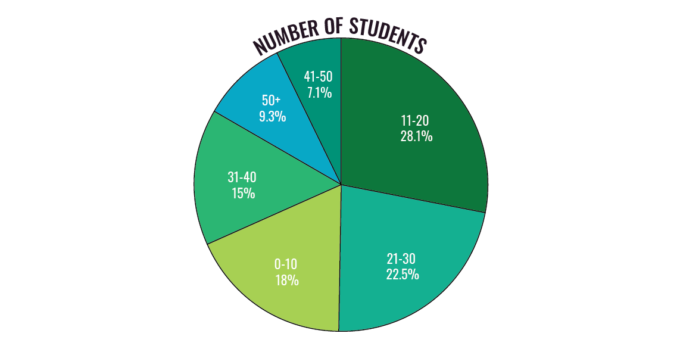
What’s the youngest age most piano teachers teach?
Nearly 95% said they take on students under the age of 7, which is even higher than our 2021 data. This trend towards teaching preschoolers and younger students is continuing.
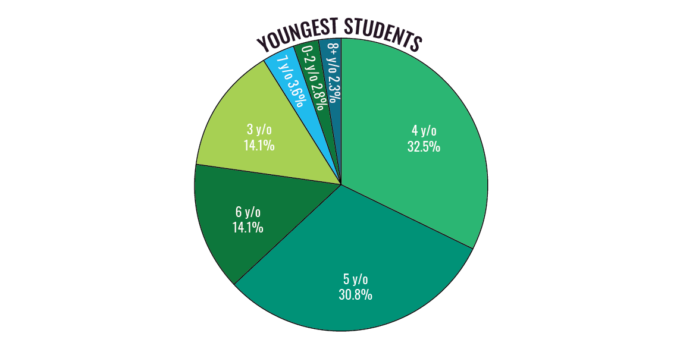
How much do music students practise?
We asked teachers to estimate the amount of practice their students are doing at home. The numbers this time were even more stark than our 2021 data.
68% of teachers are now guessing that their students do less than 1 hour of practice per week. If students are practising 6 days a week, that’s a maximum of 10 minutes a day. A very small percentage of teachers – fewer than 2% – think that their students do 3 hours or more per week, which is the equivalent of the often-cited expectation of 30 minutes a day, 6 days a week.
The practice durations are, of course, just rough estimates based on what teachers think their students are doing during the week. We asked teachers to guess the average amount of practice per week. We expected it to be lower across the board than most teachers might want, but we were surprised to see the trends declining even more from 2021’s already underwhelming numbers.
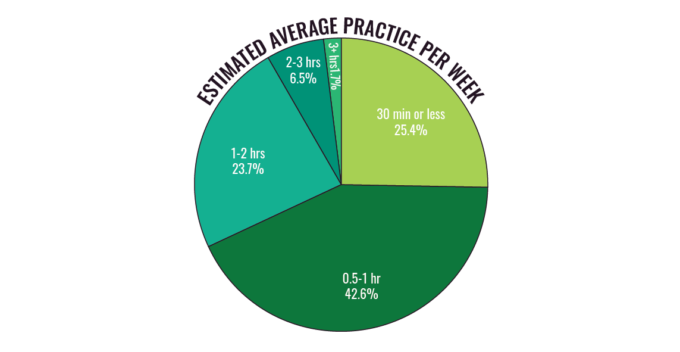
To put it plainly, students are simply practising less and less.
How long do students stay in lessons?
To get some idea of average student retention, we also asked about the number of the teachers’ students had been studying with them. This data will always skew a little on the pessimistic side, since – if a teacher is new or has recently moved their studio – there is a natural cap on the number of years a student could have been taking lessons with them.
Still, it’s good to see a sizable amount of students staying on for more than 5 years, and a handful even studying with the same teacher for 9 years or more.
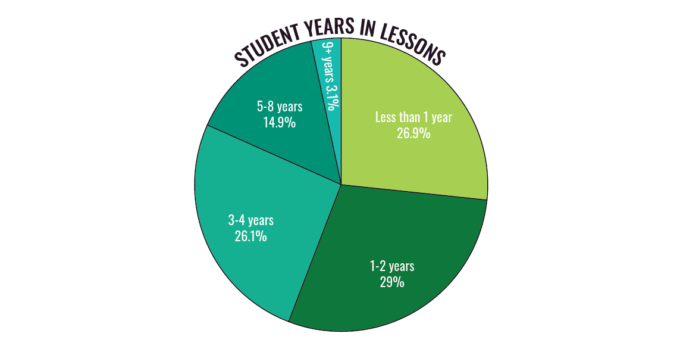
What format do we teach in?
Over 60% of teachers teach 30-minute lessons as their standard format. The overall breakdown of different lesson lengths is very similar to the 2021 report.

What are the most common method books?
Method books can never determine everything about how a particular teacher’s lessons look. However, the popularity of certain methods does provide us with some indicator of what teachers value, their priorities and – in particular – how they prefer to teach reading skills.
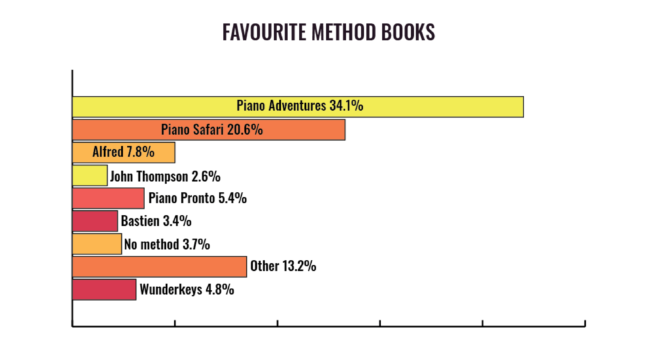
These numbers are so similar to 2021 that I had to double-, triple- and quadruple-check my work when creating this graph! Piano Safari is up about 3% from our last report, but every other method is very close to the same figure.
Wunderkeys is new to be included on the list this time, since it was a common “other” answer in the 2021 report.
What do teachers teach?
As for what’s actually included in teachers’ lessons these days, scales and sight reading were neck and neck for the most consistently included. It’s great to see games coming out just underneath them at almost 90%, as so many teachers are seeing the value of games-based teaching.
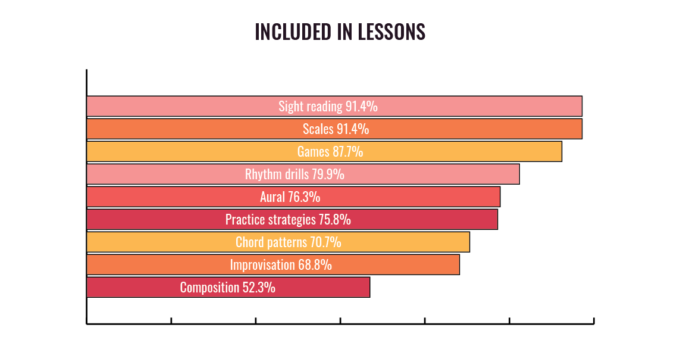
How confident are teachers?
Of the 3 areas of teaching included in our survey, confidence in teaching reading skills and rhythm skills were equal. They both average a 4 rating (on a scale of 1 – 5, with 5 being the most confident).
Teachers were less confident in how they teach technique than in our 2021 report, though not by a huge amount. This trend does seem to be going down over time, however, as 2021 was already a little lower than 2020.
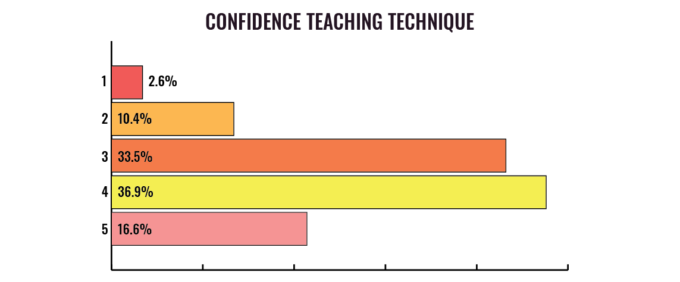
If teaching technique is a bit daunting for you, check out the VMT-exclusive resource Technique Liftoff, which provides a structured approach for teaching the basics – complete with reminder videos and backing tracks for home practice.
There are even more statistics about who we’re teaching and how our music lessons look in the report. Get your copy by entering your details below.

Subscribe to the newsletter and get the 2021 Vibrant Music Teaching Industry Report
Enter your details to subscribe to the newsletter for piano teachers with information, tips and offers.
I hate spam as much as you do! I will only send you emails related directly to piano teaching and you can unsubscribe at any time.
If you’re a member of Vibrant Music Teaching you can download the report directly here. No need to wait for an email. 🙂
One note which might influence the surveyed teachers’ confidence in various teaching areas: Fewer than 50% of the respondents have a formal teaching qualification.
The data shows that you don’t need to have a degree to be a successful music studio teacher. So let’s put “imposter syndrome” to bed for good!
Music Teaching Studio Calendars & Hours
This section was entirely new in our last report, so this is the first time we can compare data year-over-year. Here we will look into teachers’ working hours to see how much teaching and other work we do, as well as how our teaching calendars break down.
How many hours do music teachers teach each week?
When it comes to the number of teaching hours per week, our findings for most regions were pretty consistent with the 2021 report.
Europe, however, is quite a different story this time around with an average of 18 hours a week in 2023 vs. an average of 14.37 hours a week in 2021. It will be interesting to see how this pans out in our next report.
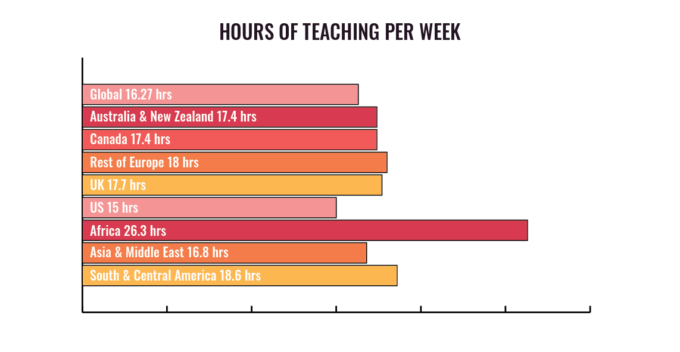
How many hours do music teachers spend on admin work each week?
Office hours vary quite a bit in the different regions, with Australia and New Zealand teachers spending the most time on planning and admin, and those in South and Central America spending the least time.
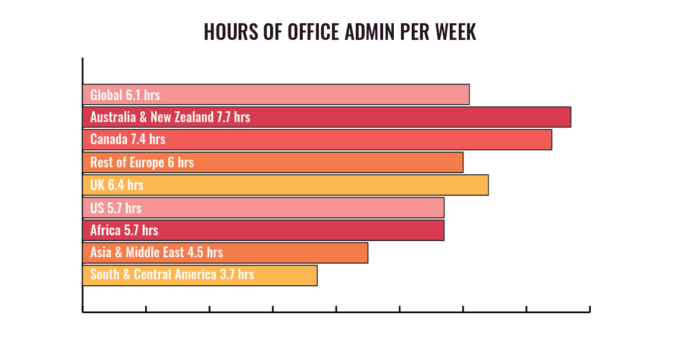
What does the average teaching calendar look like?
It’s fascinating to see how much the teaching calendar varies in different parts of the world. The results in this area are pretty similar to the 2021 report. The UK is up by about 1 week per year and Europe is down by almost 2 weeks.
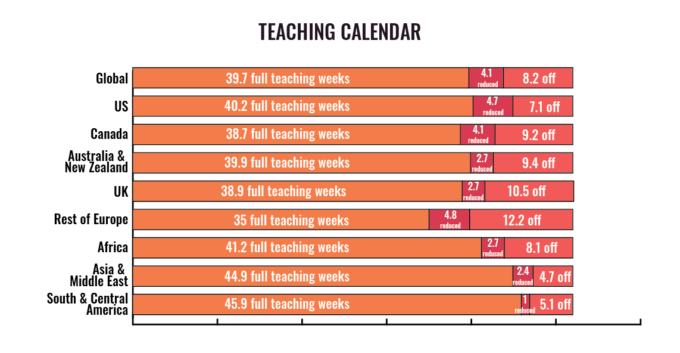
Europe is again working the fewest weeks in the year at an average of just 35 “regular” teaching weeks a year. It’s important to note here, that the largest European representation is from Ireland. If you feel these numbers don’t reflect your country, make sure to fill out our next survey so you’re represented!
The Value of Music Teaching Industry Data
I hope that some of these key findings spoke to you, and helped shed light on an area of your business. Download the full report below for more great insights.

Subscribe to updates and get the 2023 Vibrant Music Teaching Industry Report
Enter your details to subscribe to the newsletter for piano teachers with information, tips and offers.
I hate spam as much as you do! I’ll only send you information that’s directly relevant to music teachers and you can unsubscribe at any time.
If you’re a member of Vibrant Music Teaching you can download the report directly here. No need to wait for an email. 🙂
Having data can propel our industry forward. Send this report to a teaching friend and spread the word using this handy link: colourfulkeys.ie/report.
Which music teaching statistic was most interesting or surprising to you?
In the comments below, I’d love to hear your key takeaways about our statistics on teaching music lessons.
And if you have ideas for questions you want answered in future versions of the report, please chime in with those too!
Nicola, thank you so much for collecting, compiling, and sharing this data. It is much needed and I hope you update annually.
I was very surprised – shocked, in fact – by both the low group lesson numbers AND the hourly wage of group lesson teachers. I would never have expected those numbers and wonder if they are connected on a deeper level.
I hope this helps to serve as both a point of reference for teachers in valuing our services AND as an inspiration to work toward increasing that value.
Thank you again!!
I hope so too!
A very interesting and valuable survey, thank you . Especially the comparison of exams and recitals, and reading and technical skills. Wages comparison is difficult globally, but a great effort nonetheless.
Hello Nicola, I am almost finished reading PLAYFUL PRESCHOOL PIANO TEACHING. I PURCHASED THE BOOK FROM AMAZON. I wanted to find the visual lesson planning cards but do not know how to find them. At $25.oo per month I cannot afford to join. I recently closed my piano studio but am still teaching my 5 year old granddaughter and two other grandkids. She started with me at four years old. Marlene
Hi Marlene! You just need to go to the direct link mentioned in the book to download them. If you have trouble with that please email support@colourfulkeys.ie
Hi. Thanks for all the work you’ve done in this compilation . I am in southern New Jersey, I am shocked by how inexpensive Tuition fees are through the country. For a second I thought that was for a 30 minute lesson rather than paid by the hour, Now I’m curious as to how many teachers are teaching as a full-time career and are degreed. Seems we are under valuing ourselves Ty
The full-time aspect was in the report but the education level may be something we look at next year.
Oops above. “Throughout the country”
How many music teachers do work in US?
Since so many of us work from home there’s no real way to estimate that, Eugene.
Are the teachers surveyed mostly teaching pre-K to early grade school students? It would explain the large difference between exams and recitals in the US — but also the prevalence of the types of published methodology books scoring so popularly.
It’s not something we asked specifically, but that would generally be true, yes.
Thank you for the quick reply! Would you be willing to share the percentage makeup of from which these teachers hail? (That is, 20% UK, 15% US, 10% Canada, etc?)
All the data we can share is in the report. I can’t share anything further.
Thank you for doing the work in collecting and organizing this information, Nicola! 🙂 I was interested in seeing the data on favorite method books. I would be interested in seeing more of this kind of information in the future: what books/materials teachers use – whether they are books, worksheets or online resources, etc.
Thank you so much for putting together this information! I teach in the US and there are a few things that I notice and want to add. Zoom is definitely the clear favorite for executing online lessons – my thought is that parents are already very familiar with using it in their own jobs. The statistic that surprised me the most was 52% of teachers composing & improvising! Fully supportive of it – I was impressed to see such a high percentage. I was also surprised to see 92% 1v1 lessons – there are a lot of really innovative formats popping up and it’s my prediction that in 2022 we will see more teachers using a format other than 1v1. Thanks again for all of this info, it is super helpful!!
Hi Nicola and Kelly!
Also surprised by the statistic about improvisation and composition in lessons.
I’d be curious to see a statistic side by side with how comfortable piano teachers feel with improvisation in their own playing! I would guess that the statistic would be much lower, but I don’t have any concrete numbers.